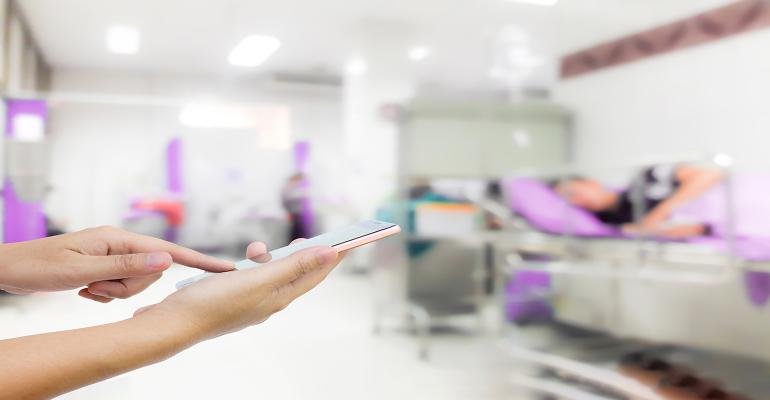As communication errors may lead to more than 70 per cent of medical errors, our hospital decided to improve communication in risky situations by using technology. The goal is to improve communication and reporting in risky situations to be under 5 minutes.
Time frame: 5 months
Approach: Our hospital developed a novel mobile application that will help in reducing the risk of medical errors through rapid reporting and ensuring prompt response to these situations by utilising one of the lean approaches, JIDOKA, which will enable staff to stop the line when they feel there is a risk of patient harm. The mobile application named “safety push” is to be used by healthcare professionals to report risky situations such as shortage of staff that may lead to patient harm. For example, when there is no staff to perform double checks, these events will be reported to supervisors and upper management in order to ensure fast and prompt response.
Target population: Healthcare workers
Stake holders: Nursing department, medical administration, quality department, information management.
Background
As per the results of a hospital patient safety culture survey, the main area for improvement, out of the 10 survey topics, according to the hospital staff was communication.
More than 50 per cent of the hospital staff reported that they have issues in reporting patient safety issues to their supervisors, and when we started interviewing them to elaborate more about this issue, they responded that it usually takes too much time to have response from supervisors.
Prolonged communication and reporting in risky situations led to adverse events such as medication error due to skipping the double check step.
Average reporting time in risky situations should be 40 to 60 minutes using the conventional occurrence variance reporting (OVR) method.
Methods
The “safety push” mobile application is a rapid way of communication that can be used by healthcare professionals to report risky issues and receive immediate response.
Approach: The IT department’s capabilities was used to develop a novel mobile application, which was created in collaboration with nursing administration, medical administration and quality department using the lean concept of “JIDOKA”, so the application would help the staff to stop the line and report risky situations and receive immediate response.
When hospital staff finds themselves in a risky situation, they can open the mobile application on their mobile phone and press the red button named: “push”, then enter their location and contacts. The notification will then go to their direct supervisor and top management.
The direct supervisor will visit the location once the notification is received and rectify the situation. If he was not able to deal with it, then the hospital director, medical director, nursing director or quality director will be notified accordingly.
After rectifying the issue, the quality department will call for a meeting to define the root causes of the problem and suggest a remedy for correction.
The new remedy will be communicated with the frontline staff, and they will receive training on it to prevent recurrence of the same problem again.
Goals: Improve communication, increase staff empowerment, ensure patient safety.
Timeframe
- Project initiation (developing the mobile application design, preparing flowcharts for mobile application process of response) 1 week
- Mobile application development: 2 months.
- Pilot in critical areas (Intensive care unit, paediatric intensive care, neonatal intensive care, operation rooms, and Haemodialysis): 1 month.
- Data collection and analysis: 2 weeks.
- Full implementation and refinements: 1 month
- Target population: All healthcare professionals.
Challenges
- Developing a functional mobile application: It was addressed using the skills of one of our IT employees who had the required skills to develop the application.
- Launching the application may lead to an unauthorised use from outside the hospital: This was addressed by limiting the access to the application by logging in using hospital username and password.
Impact
Results: After piloting the app in critical areas, the reporting time reached an average of 1 minute 36 seconds. This is instead of the 40 to 60 minutes it would take using the OVR method.
There was an improvement of in the staff feeling safe as well, which was reported during leadership patient safety rounds.

Spread and sustainability
A control plan was developed with the following steps:
- Continuous monitoring of application use by healthcare professionals with periodic quarterly training by quality department and IT department.
- Hotline (7272) was created to receive any suggestions or problems from users.
- Periodic (annual) mobile application update or when needed by IT department.
Value and innovation
The novel mobile application will help in reducing the risk of medical errors through rapid reporting and ensuring prompt response to these situations utilising one of the lean approaches to enable. the staff to stop the line when they feel there is a risk of patient harm.

Engagement
Project team
Sponsor: Director of medical affairs.
Leader: Nursing director
Facilitator: Quality section head
Members: IT programmer, medical director, head nurses from critical areas
Engagement approach: Ensuring all stakeholders participation during the developing phase and incorporating their inputs in the mobile application, ensure proper training and continue gathering and applying suggestions from end-users.

Dr Mohamed Elfaiomy
This article appears in the latest issue of Omnia Health Magazine. Read the full issue online today.



